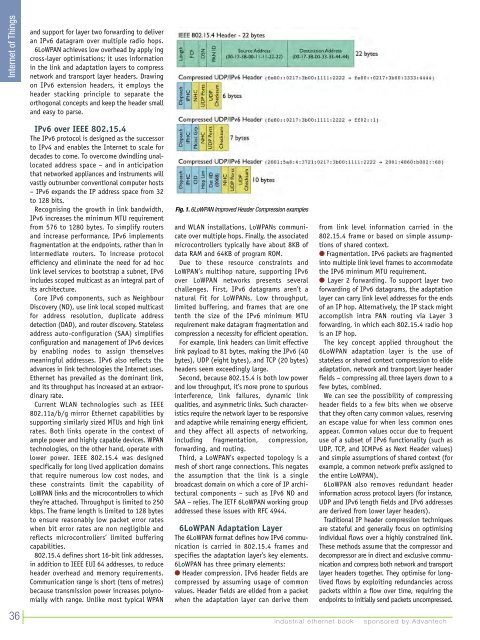industrial wireless book special edition - Networking ...
industrial wireless book special edition - Networking ...
industrial wireless book special edition - Networking ...
You also want an ePaper? Increase the reach of your titles
YUMPU automatically turns print PDFs into web optimized ePapers that Google loves.
Internet of Things<br />
and support for layer two forwarding to deliver<br />
an IPv6 datagram over multiple radio hops.<br />
6LoWPAN achieves low overhead by apply ing<br />
cross-layer optimisations; it uses information<br />
in the link and adaptation layers to compress<br />
network and transport layer headers. Drawing<br />
on IPv6 extension headers, it employs the<br />
header stacking principle to separate the<br />
orthogonal concepts and keep the header small<br />
and easy to parse.<br />
36<br />
IPv6 over IEEE 802.15.4<br />
The IPv6 protocol is designed as the successor<br />
to IPv4 and enables the Internet to scale for<br />
decades to come. To overcome dwindling unallocated<br />
address space – and in anticipation<br />
that networked appliances and instruments will<br />
vastly outnumber conventional computer hosts<br />
– IPv6 expands the IP address space from 32<br />
to 128 bits.<br />
Recognising the growth in link bandwidth,<br />
IPv6 increases the minimum MTU requirement<br />
from 576 to 1280 bytes. To simplify routers<br />
and increase performance, IPv6 implements<br />
fragmentation at the endpoints, rather than in<br />
intermediate routers. To increase protocol<br />
efficiency and eliminate the need for ad hoc<br />
link level services to bootstrap a subnet, IPv6<br />
includes scoped multicast as an integral part of<br />
its architecture.<br />
Core IPv6 components, such as Neighbour<br />
Discovery (ND), use link local scoped multicast<br />
for address resolution, duplicate address<br />
detection (DAD), and router discovery. Stateless<br />
address auto-configuration (SAA) simplifies<br />
configuration and management of IPv6 devices<br />
by enabling nodes to assign themselves<br />
meaningful addresses. IPv6 also reflects the<br />
advances in link technologies the Internet uses.<br />
Ethernet has prevailed as the dominant link,<br />
and its throughput has increased at an extraordinary<br />
rate.<br />
Current WLAN technologies such as IEEE<br />
802.11a/b/g mirror Ethernet capabilities by<br />
supporting similarly sized MTUs and high link<br />
rates. Both links operate in the context of<br />
ample power and highly capable devices. WPAN<br />
technologies, on the other hand, operate with<br />
lower power. IEEE 802.15.4 was designed<br />
specifically for long lived application domains<br />
that require numerous low cost nodes, and<br />
these constraints limit the capability of<br />
LoWPAN links and the microcontrollers to which<br />
they’re attached. Throughput is limited to 250<br />
kbps. The frame length is limited to 128 bytes<br />
to ensure reasonably low packet error rates<br />
when bit error rates are non negligible and<br />
reflects microcontrollers’ limited buffering<br />
capabilities.<br />
802.15.4 defines short 16-bit link addresses,<br />
in addition to IEEE EUI 64 addresses, to reduce<br />
header overhead and memory requirements.<br />
Communication range is short (tens of metres)<br />
because transmission power increases polynomially<br />
with range. Unlike most typical WPAN<br />
Fig. 1. 6LoWPAN Improved Header Compression examples<br />
and WLAN installations, LoWPANs communicate<br />
over multiple hops. Finally, the associated<br />
microcontrollers typically have about 8KB of<br />
data RAM and 64KB of program ROM.<br />
Due to these resource constraints and<br />
LoWPAN’s multihop nature, supporting IPv6<br />
over LoWPAN networks presents several<br />
challenges. First, IPv6 datagrams aren’t a<br />
natural fit for LoWPANs. Low throughput,<br />
limited buffering, and frames that are one<br />
tenth the size of the IPv6 minimum MTU<br />
requirement make datagram fragmentation and<br />
compression a necessity for efficient operation.<br />
For example, link headers can limit effective<br />
link payload to 81 bytes, making the IPv6 (40<br />
bytes), UDP (eight bytes), and TCP (20 bytes)<br />
headers seem exceedingly large.<br />
Second, because 802.15.4 is both low power<br />
and low throughput, it’s more prone to spurious<br />
interference, link failures, dynamic link<br />
qualities, and asymmetric links. Such characteristics<br />
require the network layer to be responsive<br />
and adaptive while remaining energy efficient,<br />
and they affect all aspects of networking,<br />
including fragmentation, compression,<br />
forwarding, and routing.<br />
Third, a LoWPAN’s expected topology is a<br />
mesh of short range connections. This negates<br />
the assumption that the link is a single<br />
broadcast domain on which a core of IP architectural<br />
components – such as IPv6 ND and<br />
SAA – relies. The IETF 6LoWPAN working group<br />
addressed these issues with RFC 4944.<br />
6LoWPAN Adaptation Layer<br />
The 6LoWPAN format defines how IPv6 communication<br />
is carried in 802.15.4 frames and<br />
specifies the adaptation layer’s key elements.<br />
6LoWPAN has three primary elements:<br />
● Header compression. IPv6 header fields are<br />
compressed by assuming usage of common<br />
values. Header fields are elided from a packet<br />
when the adaptation layer can derive them<br />
<strong>industrial</strong> ethernet <strong>book</strong><br />
from link level information carried in the<br />
802.15.4 frame or based on simple assumptions<br />
of shared context.<br />
● Fragmentation. IPv6 packets are fragmented<br />
into multiple link level frames to accommodate<br />
the IPv6 minimum MTU requirement.<br />
● Layer 2 forwarding. To support layer two<br />
forwarding of IPv6 datagrams, the adaptation<br />
layer can carry link level addresses for the ends<br />
of an IP hop. Alternatively, the IP stack might<br />
accomplish intra PAN routing via Layer 3<br />
forwarding, in which each 802.15.4 radio hop<br />
is an IP hop.<br />
The key concept applied throughout the<br />
6LoWPAN adaptation layer is the use of<br />
stateless or shared context compression to elide<br />
adaptation, network and transport layer header<br />
fields – compressing all three layers down to a<br />
few bytes, combined.<br />
We can see the possibility of compressing<br />
header fields to a few bits when we observe<br />
that they often carry common values, reserving<br />
an escape value for when less common ones<br />
appear. Common values occur due to frequent<br />
use of a subset of IPv6 functionality (such as<br />
UDP, TCP, and ICMPv6 as Next Header values)<br />
and simple assumptions of shared context (for<br />
example, a common network prefix assigned to<br />
the entire LoWPAN).<br />
6LoWPAN also removes redundant header<br />
information across protocol layers (for instance,<br />
UDP and IPv6 length fields and IPv6 addresses<br />
are derived from lower layer headers).<br />
Traditional IP header compression techniques<br />
are stateful and generally focus on optimising<br />
individual flows over a highly constrained link.<br />
These methods assume that the compressor and<br />
decompressor are in direct and exclusive communication<br />
and compress both network and transport<br />
layer headers together. They optimise for longlived<br />
flows by exploiting redundancies across<br />
packets within a flow over time, requiring the<br />
endpoints to initially send packets uncompressed.<br />
sponsored by Advantech

















